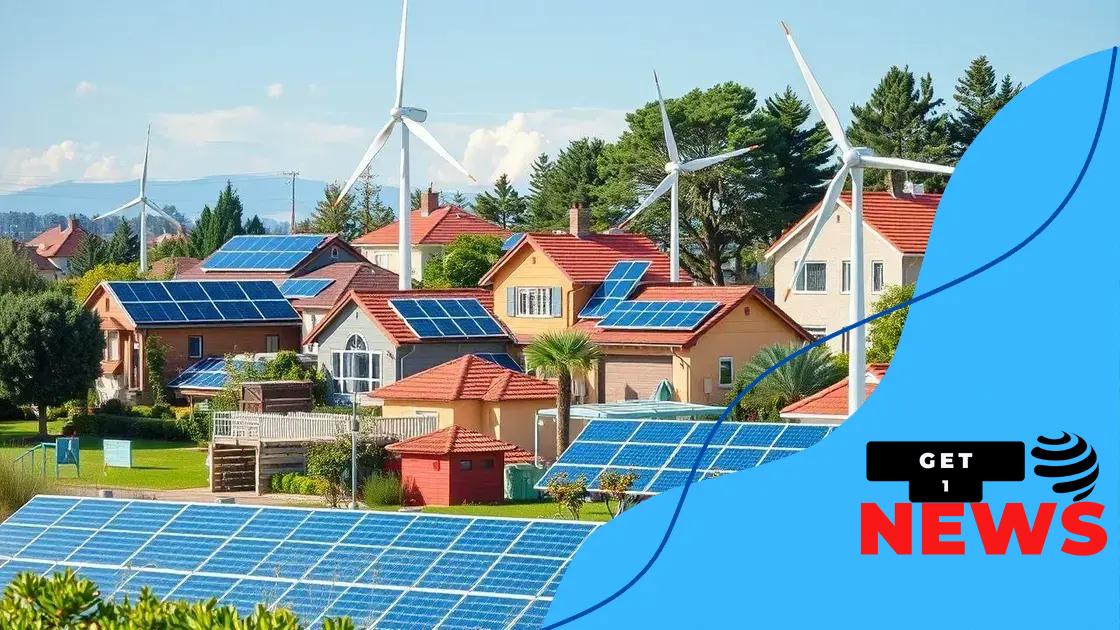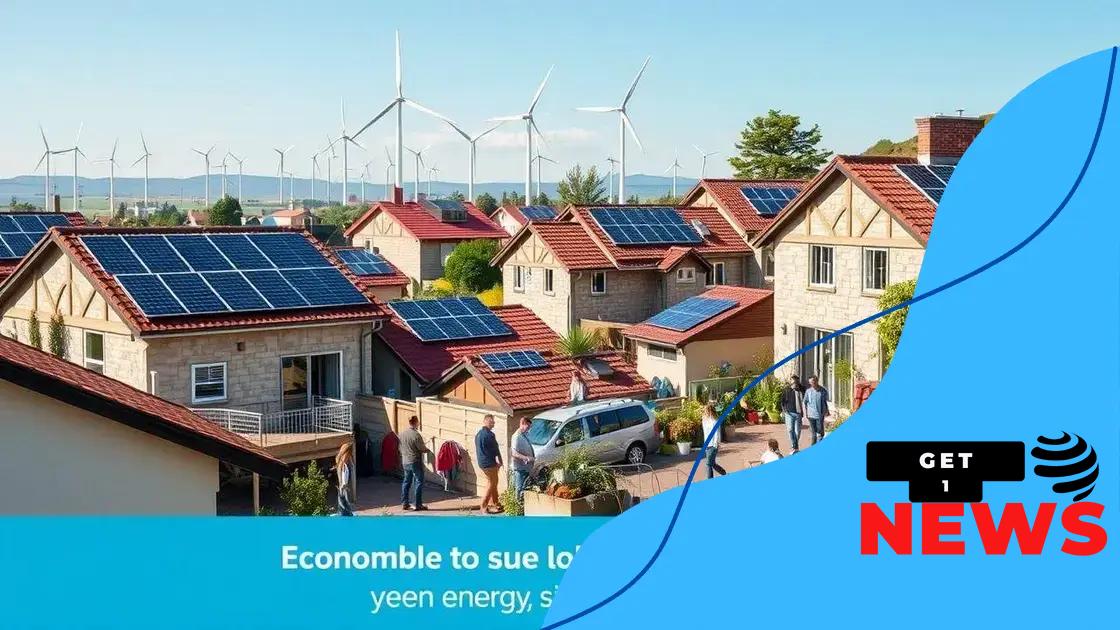Renewable energy subsidies in public programs: what you need to know

Renewable energy subsidies are financial incentives that promote sustainable energy practices, creating jobs, reducing costs, and driving economic growth while facing challenges in implementation and public awareness.
Renewable energy subsidies in public programs play a crucial role in promoting sustainable practices. Have you wondered how these incentives can transform your community? Let’s dive into the details of this vital subject.
Understanding renewable energy subsidies
Understanding renewable energy subsidies is essential for grasping how these initiatives support sustainable practices. These financial incentives are designed to encourage the adoption of clean energy sources, such as wind and solar power. By breaking down the components of these subsidies, we can see their significance in today’s energy landscape.
What Are Renewable Energy Subsidies?
Renewable energy subsidies refer to various forms of financial support given by governments to promote the use of renewable energy. They can come in direct funding, tax incentives, or grants. This assistance aims to lower the cost barriers for businesses and consumers alike, making it easier to invest in clean energy technologies.
Types of Subsidies
- Investment Tax Credits: These credits allow investors to deduct a specific percentage of their investment from their taxes.
- Production Tax Credits: These provide a tax incentive based on the amount of energy produced from renewable sources.
- Grants and Loans: Governments may offer financial aid to cover the upfront costs of renewable energy projects.
- Feed-in Tariffs: These guarantee a fixed price for renewable energy producers for a set period.
Through these subsidies, renewable energy becomes more attractive for individuals and companies. They lower the financial risks involved in transitioning to sustainable sources of power. As awareness grows about the need for greener energy practices, these subsidies are becoming increasingly crucial.
However, understanding the challenges faced by these subsidy programs is equally important. Funding may fluctuate based on government priorities and budget constraints. Moreover, there could be local resistance to projects due to the perceived costs or land-use concerns. Hence, it’s vital to craft policies that resonate with the public while ensuring support for renewable initiatives.
Renewable energy subsidies not only provide economic benefits but also lead to significant environmental impacts. They play a key role in reducing greenhouse gas emissions and combating climate change. With the right adjustments and public support, these programs can pave the way for a cleaner and more sustainable future.
Types of subsidies in public programs
Understanding the types of subsidies in public programs is crucial for grasping how they promote renewable energy. These subsidies come in various forms, each playing a unique role in supporting the transition to cleaner energy sources. Let’s explore the major types available to individuals and businesses.
1. Direct Grants
Direct grants are funds provided by the government to eligible projects without needing repayment. These can cover the full cost of installation for technologies like solar panels. Such financial assistance encourages greater investment in renewable resources.
2. Tax Credits
Tax credits are a significant incentive. The government allows taxpayers to deduct a portion of the costs associated with renewable energy installations from their annual taxes. This reduces the overall cost for the consumers, making such options more affordable.
3. Feed-in Tariffs
Feed-in tariffs guarantee a fixed payment rate for energy generated from renewable sources. Homeowners and businesses selling back power to the grid benefit from predictable income, encouraging widespread adoption of technologies like solar and wind.
4. Loans and Financing Options
- Low-Interest Loans: These loans make it easier to finance renewable energy projects.
- Energy Efficiency Financing: Programs that help cover costs of energy-efficient upgrades.
- On-Bill Financing: Costs are added to utility bills, allowing payments over time.
Each type of subsidy enables greater access to renewable technologies. They aim to lower financial barriers and promote public interest in sustainable energy practices. As awareness of environmental concerns grows, these subsidies will likely evolve to meet changing needs and priorities. By leveraging these various forms of support, both individuals and communities can maximize their transition to renewable energy.
Impact on local economies

The impact of renewable energy subsidies on local economies is significant and multi-faceted. These financial incentives encourage investment in sustainable technologies, which can result in various economic benefits for communities.
Job Creation
One of the most direct impacts is the creation of jobs. Renewable energy projects, such as solar and wind farms, require a skilled workforce for installation, maintenance, and operation. These jobs often pay well and contribute to local economies.
Increased Local Investment
As subsidies lower the cost of entry, more local businesses are likely to invest in renewable technologies. This increased investment can lead to an influx of revenue that stimulates growth in other sectors. For example, construction companies may see increased demand for their services as new renewable projects are developed.
Community Sustainability
- Reducing Energy Costs: Local residents benefit from lower energy bills due to the adoption of renewable resources.
- Stability in Energy Prices: By using local energy sources, communities reduce their dependence on volatile external energy markets.
- Enhanced Energy Independence: As communities rely more on their local renewable resources, they can achieve greater energy autonomy.
Furthermore, communities that embrace renewable energy subsidies often see a boost in tourism. Attractive features like solar farms or wind turbines can enhance the area’s green reputation. As the world increasingly prioritizes sustainability, local economies become more appealing to individuals and businesses looking to invest or relocate.
However, it’s crucial to recognize that the transition to renewable energy also comes with challenges. Local economies may need to adapt to changes in the job market and ensure that workers receive the training necessary to take on new roles in the renewable sector. Balancing growth while addressing these challenges can lead to a more robust local economy that benefits everyone.
Challenges in implementing subsidies
Implementing renewable energy subsidies presents a variety of challenges that can hinder their effectiveness. Understanding these challenges is essential for creating better programs that benefit both communities and the environment. One significant challenge is securing funding. Many subsidy programs rely on government budgets, which can fluctuate based on economic conditions and political priorities.
Complex Regulatory Frameworks
The regulatory environment surrounding renewable energy can also be complex. Navigating through various state and federal laws may slow down the deployment of subsidy programs. Sometimes, programs may overlap or conflict with each other, creating confusion for those trying to access the subsidies.
Public Awareness
Public awareness plays a critical role in how well these subsidies are received. Many individuals may not be fully informed about available options, limiting participation. Educational campaigns can help bridge this gap and encourage community members to take advantage of available resources.
Distribution Inequality
- Geographic Limitations: Certain regions may not have equal access to renewable resources, leading to uneven benefits.
- Income Disparities: Lower-income households might face barriers in upfront costs, despite subsidies being in place.
- Access to Financing: Not everyone can secure financing to take advantage of subsidies, limiting their effectiveness.
Furthermore, limited awareness of long-term benefits can be problematic. Some communities may focus on immediate costs rather than understanding how subsidies can lead to long-term savings through lower energy bills. This misunderstanding may keep potential beneficiaries from participating in subsidy programs.
Lastly, political opposition can emerge during the implementation phase, particularly from those who prioritize traditional energy sources. Overcoming such resistance requires not only well-structured subsidy programs but also strong advocacy for renewable energy initiatives. Addressing these challenges effectively will enhance the long-term success of renewable energy subsidies.
Future of renewable energy funding
The future of renewable energy funding is bright, with many trends indicating a shift toward increased investment in sustainable technologies. As concerns about climate change continue to grow, both public and private sectors are focusing more on funding strategies that support renewable energy development.
Emerging Financial Models
Innovative financial models are being developed to support renewable energy projects. For example, community-funded solar initiatives allow residents to invest in local energy projects, generating returns while promoting clean energy. These models not only empower communities but also create a sense of ownership over the energy produced.
Increased Government Support
Governments worldwide are recognizing the importance of transitioning to renewable energy. This recognition is clear in their commitments to increase funding for clean technologies. Many countries are implementing long-term policies that provide stability for investors, ensuring continued growth in the renewable sector.
Collaboration with Private Sector
- Public-Private Partnerships: Collaborations between governments and private companies can pool resources and expertise.
- Venture Capital Investments: More venture capital funds are focusing on renewable energy startups, fostering innovation.
- Green Bonds: These are raising money for projects with environmental benefits, making it easier to fund renewable initiatives.
As more businesses recognize the financial advantages of switching to renewable resources, private investments are likely to increase. Apart from direct financial benefits, companies involved in sustainability efforts often see improved reputations and customer loyalty.
Technological advancements will also play a crucial role in the future of renewable energy funding. Innovations that reduce costs associated with renewable technologies make them more accessible. As prices continue to drop, funding sources can become more widely available, leading to enhanced deployment of clean energy systems.
FAQ – Frequently Asked Questions about Renewable Energy Subsidies
What are renewable energy subsidies?
Renewable energy subsidies are financial incentives from governments to promote the adoption of clean energy technologies, like solar and wind.
How do these subsidies benefit local economies?
They create jobs, encourage local investments, and help communities reduce energy costs, fostering economic growth.
What challenges are faced in implementing these subsidies?
Challenges include securing funding, complex regulations, lack of public awareness, and distribution inequalities.
What does the future hold for renewable energy funding?
The future looks promising with innovative financial models, increased government support, and collaboration between public and private sectors.





